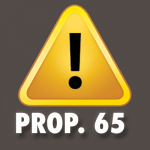 WARNING: Beginning August 30, 2018, new Proposition 65 regulations will take effect that significantly overhaul longstanding warning regulations and depart from the rules that businesses have relied on for decades.
WARNING: Beginning August 30, 2018, new Proposition 65 regulations will take effect that significantly overhaul longstanding warning regulations and depart from the rules that businesses have relied on for decades.
Accordingly, it is imperative that businesses operating or selling into California reassess and potentially overhaul their long-established Proposition 65 compliance programs before the effective date.
Failure to comply could subject businesses to potential liability, including penalties of up to $2,500 per day, per violation, as well as injunctive relief (for example, a court order requiring a product to be reformulated to remove the listed chemical) and attorney fees.
This story highlights the most important changes and explains how those changes apply to manufacturers, distributors, and retailers.
Current/Pre-August 30 Rules
Under current Proposition 65 regulations, businesses with 10 or more employees are required to provide a “clear and reasonable” warning before exposing individuals in California to any chemical listed by the state for its potential to cause cancer or reproductive toxicity.
Because the thresholds under Proposition 65 are so low, even a very small amount of any Proposition 65 listed chemical will be enough to support a claim against your company. See the list on the Office of Environmental Health Hazard Assessment (OEHHA) website, oehha.ca.gov.
The best way to protect your company from such a claim is to provide warnings that fall within the Proposition 65 regulations’ “safe harbor” provisions, which set forth specific warning language and methods of transmission that the state has deemed “clear and reasonable.”
New/August 30 Regulations
The new regulations continue to provide “safe harbor” warning content and methods for consumer product exposures, environmental exposures, occupational exposures, and tailored “safe harbor” warnings and methods for specific types of products and facilities.
However, the new regulations significantly revise the required content and specify separate safe harbor warnings based on the types of listed chemicals, the number of listed chemicals, and the method of transmission.
In addition, businesses have the option to provide two different types of safe harbor warnings: a full warning and an abbreviated “short-form” warning if the warning is placed on the product. However, companies that use the so-called “on product” warning face different size requirements.
The short-form, on-product warning “must be in a type size no smaller than the largest type size used for other consumer information on the product.”
Finally, the new regulations also clarify the responsibility between manufacturers, retailers and others in the supply chain to provide warnings.
Required New Content
• “Can Expose”: Consumer product warnings must begin with “This product can expose you to . . .” This is a departure from the current warning regulations, which require safe harbor warnings to begin with “This product contains . . .”
• Chemical Specification: If a warning is not provided on the product itself, such as on a shelf display or a store sign, a business must name at least one chemical for which the warning is being provided and specify whether that chemical is known to cause birth defects or reproductive harm, cancer, or both. If warning for one chemical that is a carcinogen and a separate chemical that is a reproductive toxicant, the warning must specify both chemicals. If warning for one chemical that is both a carcinogen and a reproductive toxicant, such as lead, the warning need only specify that chemical. This is a significant change. With the exception of warnings for alcohol, the prior safe harbor warnings do not require warnings to specify chemicals.
• Pictogram: All safe harbor warnings except for food and dietary supplement exposures must contain a pictogram on the left side of the warning of an exclamation point encompassed by an equilateral triangle. Although the triangle must be printed in yellow, it may be printed in black-and-white only if the sign, label, or shelf tag for the product is not printed using the color yellow.
• URL: All safe harbor warnings must end with “For more information go to www.P65Warnings.ca.gov.”
• Translation Requirements: Safe harbor warnings must be provided in English, and if a product sign, label, or shelf tag used to provide a warning also contains consumer information in a language other than English, the Proposition 65 warning also must be provided in that language.
Examples
Full Cancer Warning
![]() WARNING: This product can expose you to chemicals including [name of one or more chemicals], which is [are] known to the State of California to cause cancer. For more information go to www.P65Warnings.ca.gov.
WARNING: This product can expose you to chemicals including [name of one or more chemicals], which is [are] known to the State of California to cause cancer. For more information go to www.P65Warnings.ca.gov.
Truncated/Short-Form Cancer Warning
![]() WARNING: Cancer –
WARNING: Cancer –
www.P65Warnings.ca.gov
Not Legal Advice
This information is not intended to convey or constitute legal advice, and is not a substitute for obtaining legal advice from a qualified attorney. You should not act upon any such information without first seeking qualified professional counsel.
To read the full regulation, visit the OEHHA website: http://oehha.ca.gov/media/downloads/crnr/art6regtextclean090116.pdf.
OEHHA also has posted a questions-and-answers document about the warning requirements for businesses: https://oehha.ca.gov/media/downloads/crnr/art6businessqa.pdf.

